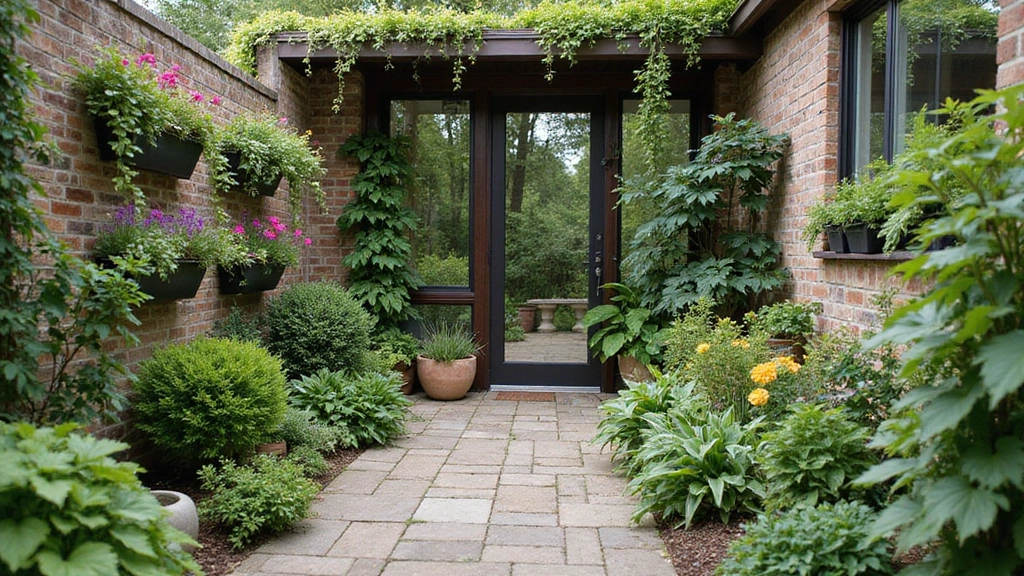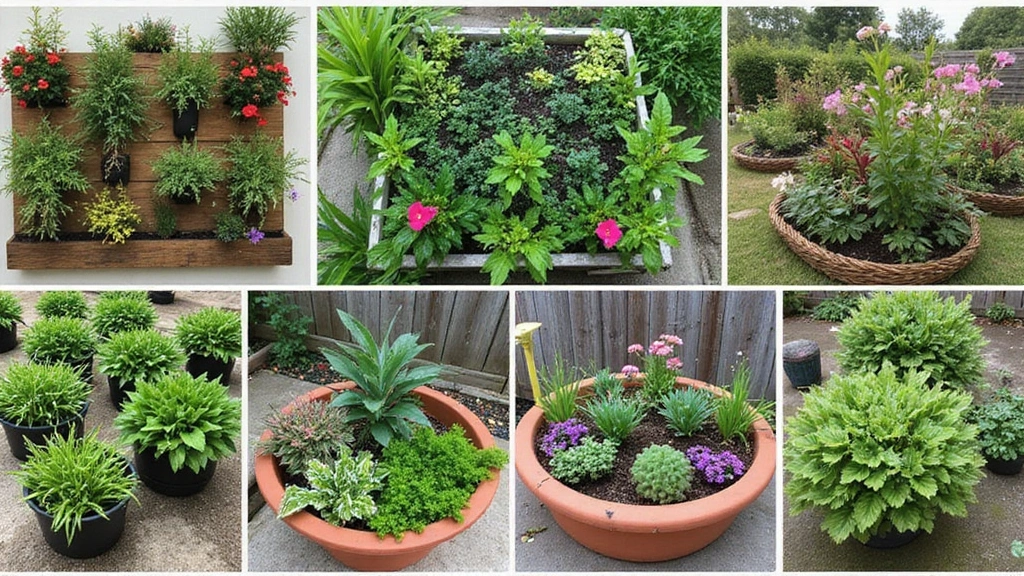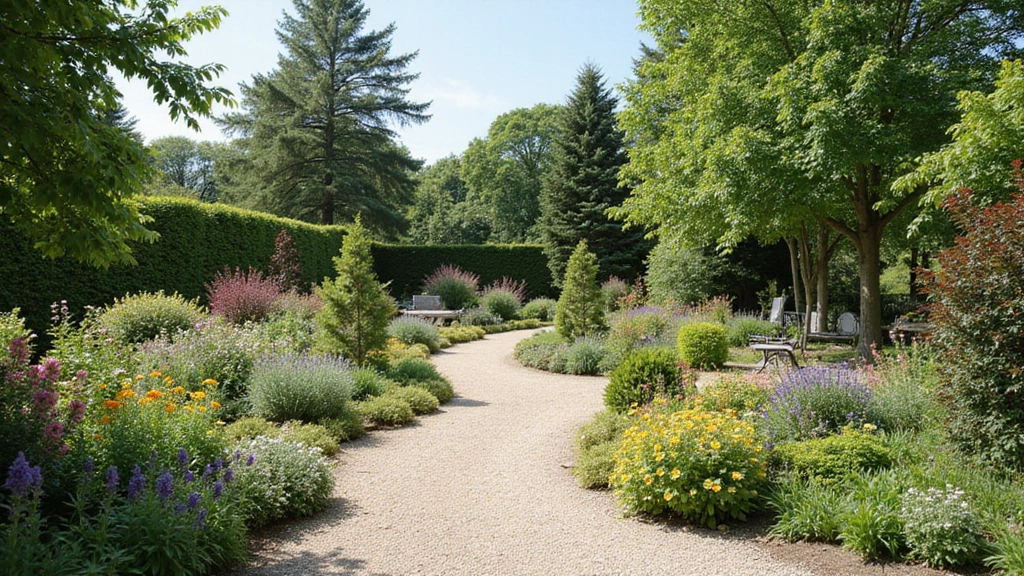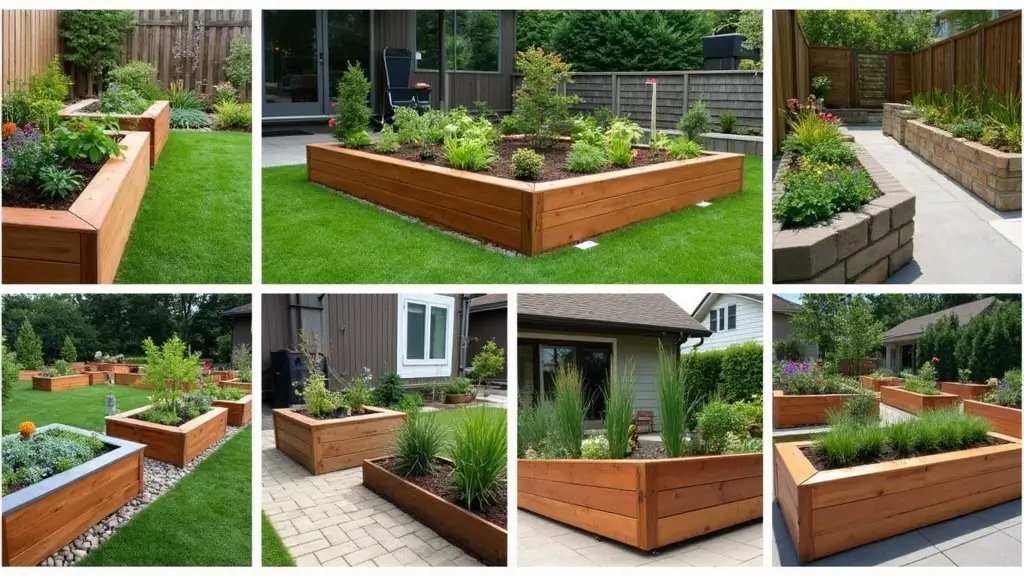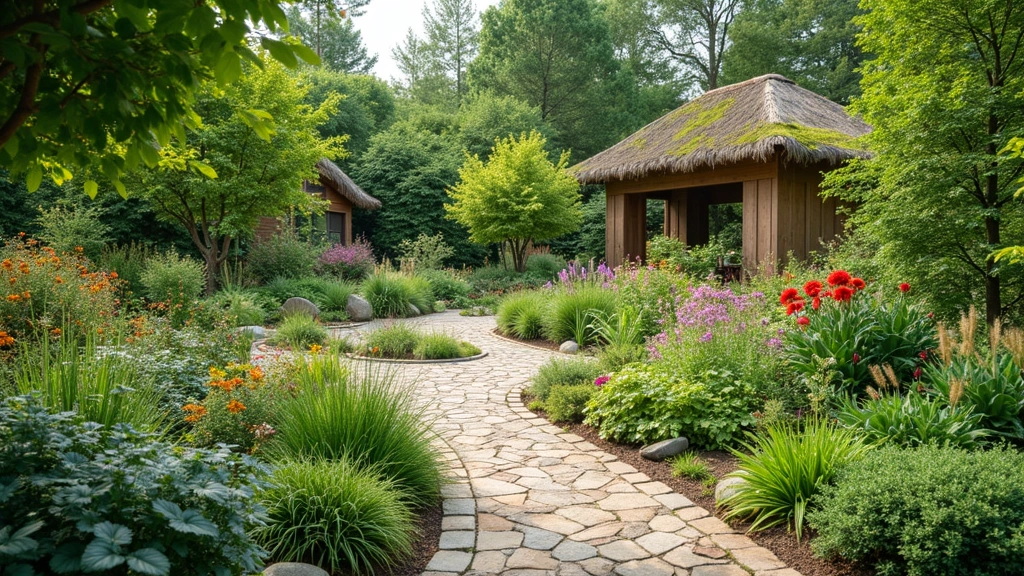Small gardens can be a haven of beauty and productivity, even in the tiniest of spaces. With the right design elements, every inch can be utilized to create a lush, organic paradise that not only pleases the eye but also sustains the soul.
From vertical gardens to container arrangements, these creative ideas will inspire you to transform your limited outdoor space into a vibrant oasis. Whether you’re looking to grow your own herbs, vegetables, or simply enjoy the beauty of flowering plants, small garden design is about finding innovative solutions and maximizing your resources. Let’s dive into these 25 inspiring ideas that will help you make the most of your small garden!
1. Vertical Gardening: Grow Upwards
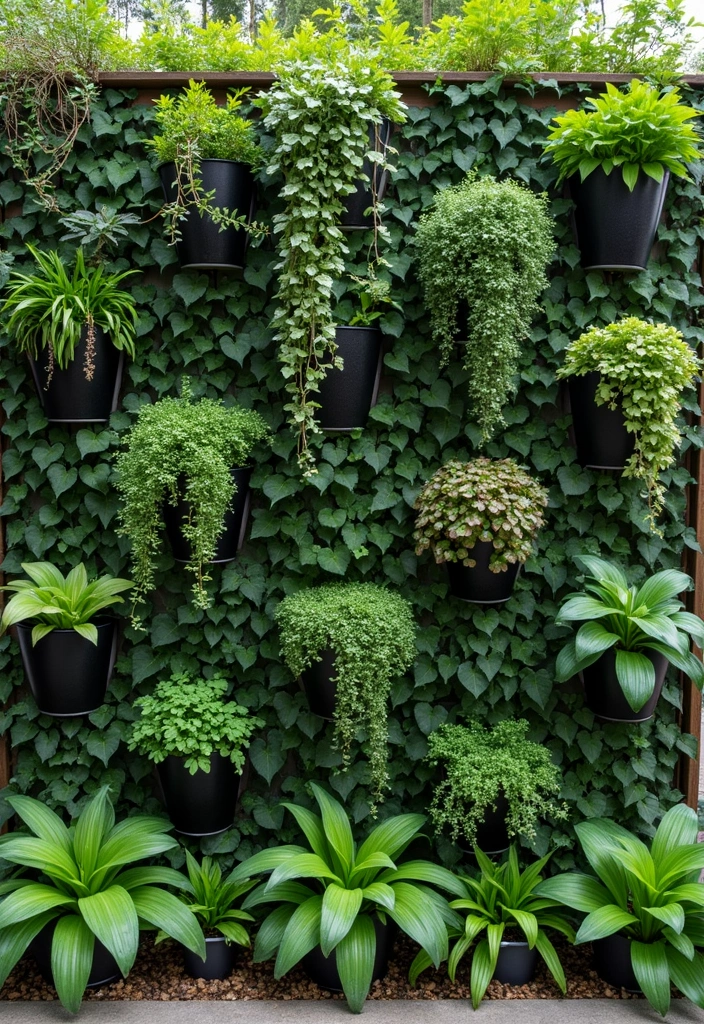
Vertical gardening is a fantastic way to maximize space while adding a stunning visual element to your garden. By utilizing trellises, wall-mounted planters, or even repurposed pallets, you can create a thriving vertical garden that’s both functional and beautiful. This method works perfectly for herbs, leafy greens, and even decorative flowers.
Consider incorporating climbing plants like beans or peas, which can grow upward, saving precious ground space. Hanging planters can also be used to showcase vibrant blooms or fragrant herbs right at eye level. For instance, the Mr. Stacky 5 Tier Stackable Strawberry, Herb, Flower, and Vegetable Planter is a great option for maximizing your vertical space while keeping your plants organized and accessible.
To support your climbing plants, a sturdy structure is essential. The Garden Obelisk Trellis for Climbing Plants provides just the right support for heavy vines and can add an elegant touch to your outdoor space.
When it comes to keeping your plants healthy, grouping those with similar sun and water needs together is crucial. Additionally, consider implementing a drip irrigation system to make watering easier. The Rain Bird DRIPKITBAG Drip Irrigation Repair and Expansion Kit can help you efficiently manage water delivery, ensuring that your vertical garden thrives.
With clever designs and the right tools, your vertical garden can turn a bare wall into a lush tapestry of greens and colors.
2. Container Gardening: Flexibility and Style
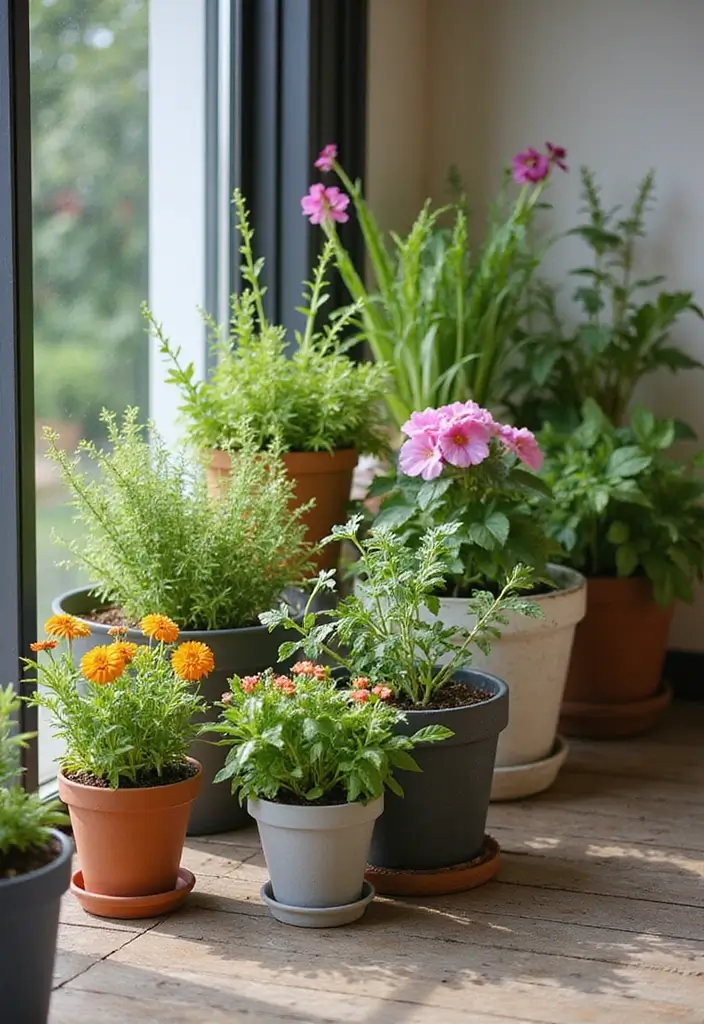
Container gardening is all about flexibility, allowing you to rearrange and change your garden layout as needed. With pots, troughs, and raised beds, you can create a beautiful, organized look that suits your style. This method is especially useful for small spaces, where traditional in-ground planting isn’t an option.
When choosing containers, opt for a variety of sizes and materials. For instance, terracotta plant pots add rustic charm to your space and come equipped with drainage holes to prevent waterlogging, ensuring your plants thrive. Alternatively, if you prefer a modern touch, consider metal garden planters, which are durable and stylish, offering a perfect home for your vegetables or flowers.
You can even get creative with repurposed items, like old wheelbarrows or crates, to give a unique flair. To boost your container garden’s health, use high-quality potting soil, like the Back to the Roots organic blend, which provides essential nutrients for your plants.
Here’s how to make container gardening work for you:
– Select containers with drainage holes to prevent waterlogging.
– Use high-quality potting soil to provide essential nutrients.
– Group plants with similar sunlight and watering needs for better maintenance.
Container gardens can enhance your space and bring life to any area, even if it’s just a small balcony or patio.
3. Raised Garden Beds: Elevated Growing
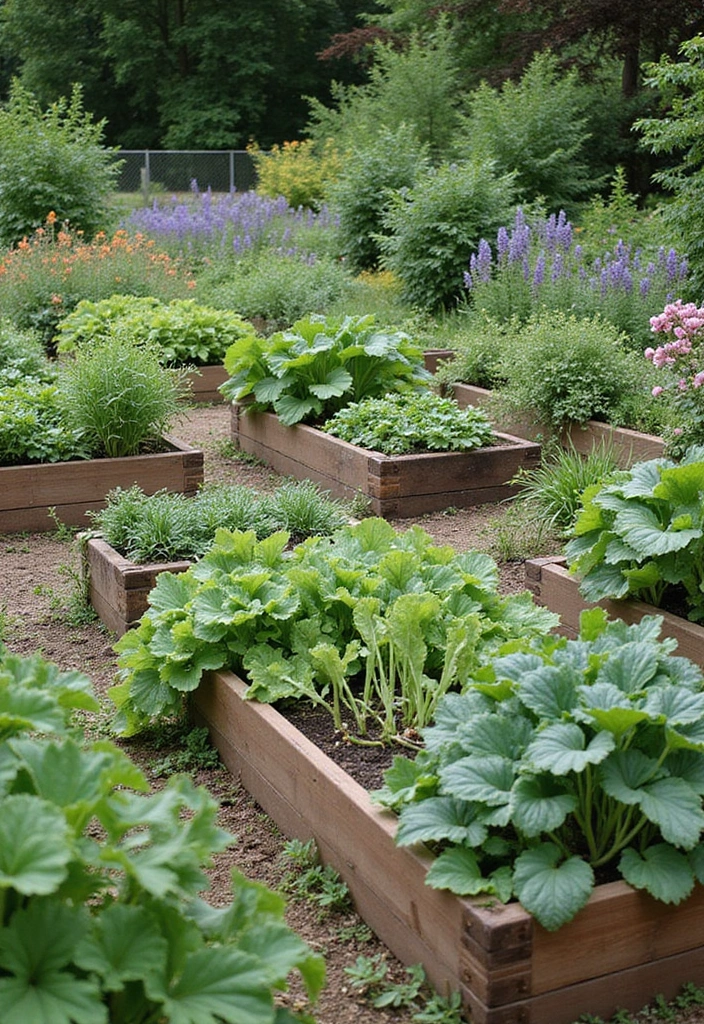
Raised garden beds simplify gardening tasks and improve drainage while reducing the need to bend over. You can easily build them using materials like wood, stone, or even metal, making them a versatile option for any small garden layout. For a sturdy and stylish option, consider the metal raised garden bed, which is perfect for growing organic vegetables, as it offers better control over soil quality.
These beds can be organized in a grid pattern or staggered for a more relaxed feel. Planting on pathways in between beds also lets you utilize every inch of space effectively.
Here are some benefits of raised garden beds:
– Better drainage allows for healthy root growth
– Reduces soil compaction, leading to improved aeration
– Easier access for planting and harvesting
To ensure your plants thrive, pairing your raised beds with quality soil is essential. The garden soil mix for raised beds is designed for container plants, flowers, and vegetables, providing essential nutrients and feeding for up to six months.
With a bit of creativity, raised beds can also serve as decorative features, adding layers and interest to your garden design. Each of these products not only enhances your gardening experience but also helps you make the most of your small garden space.
4. Edible Landscaping: Beauty Meets Function

Edible landscaping combines aesthetics with practicality by integrating fruits, vegetables, and herbs into your garden design. This way, every plant serves a dual purpose: it beautifies your space while providing fresh produce. Consider incorporating berry bushes, fruit trees, and herb gardens in your flower beds for a vibrant look.
Attractive varieties of vegetables, like purple kale or multi-colored carrots, not only taste great but also add visual interest to your edible landscape. To help you get started, a Raised Garden Bed Kit is an excellent choice for efficiently organizing your plants. Its galvanized design ensures durability while maximizing your growing space.
To further enhance your edible garden, think about layering plants by height. Choosing perennial plants also offers low-maintenance options, allowing you to enjoy your garden without too much effort. A Herb Garden Starter Kit can be perfect for growing a variety of herbs, which can be interplanted within flower beds to help deter pests naturally.
If you’re short on space, consider using a vertical garden. The Vertical Garden Planter allows you to stack your plants vertically, making it easy to grow strawberries, herbs, and vegetables in a small area.
Edible landscaping can transform an ordinary yard into a lush, productive garden that’s a feast for the eyes and the palate, all while utilizing practical and beautiful solutions.
5. Herb Gardens: Flavors on a Smaller Scale
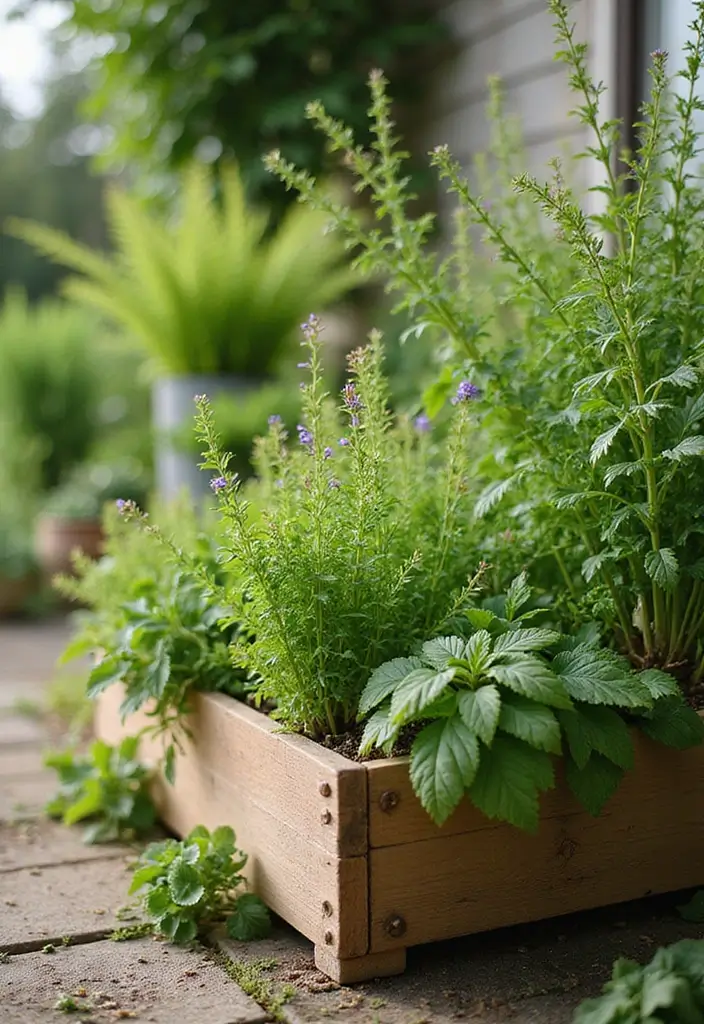
Creating a dedicated herb garden is an excellent way to incorporate fresh flavors into your cooking while beautifying your space. Herbs are typically small, and many can thrive in compact areas, making them perfect for small gardens. You can grow them in containers, raised beds, or even as part of your existing flower beds.
For ease of maintenance and to ensure your herbs thrive, consider using self-watering planters. These planters help you manage water levels efficiently, reducing the frequency of watering while keeping your herbs happy. Common herbs like basil, thyme, and rosemary not only entice with their aromas but also attract beneficial insects. Grouping herbs based on their sunlight needs and watering preferences can further simplify your gardening routine.
Here are some tips for successful herb gardening:
– Regularly trim your herbs to encourage growth and prevent going to seed.
– Mix perennials and annuals for continuous harvests.
– Consider using organic neem oil as a natural remedy to deal with pests. It’s safe for your plants and offers a gentle solution to keeping them healthy.
An herb garden is not just useful in the kitchen; its scent and beauty can also uplift your garden ambiance. If you’re just starting out, a herb garden starter kit can be a great investment. This kit provides all the essentials to help you cultivate flavors in compact spaces while inviting nature’s helpers into your kitchen.
Fresh herbs can elevate any dish while beautifying your small garden – it’s a win-win! Cultivate flavors in compact spaces and invite nature’s helpers into your kitchen.
6. Succulent and Cacti Gardens: Low Maintenance Charm
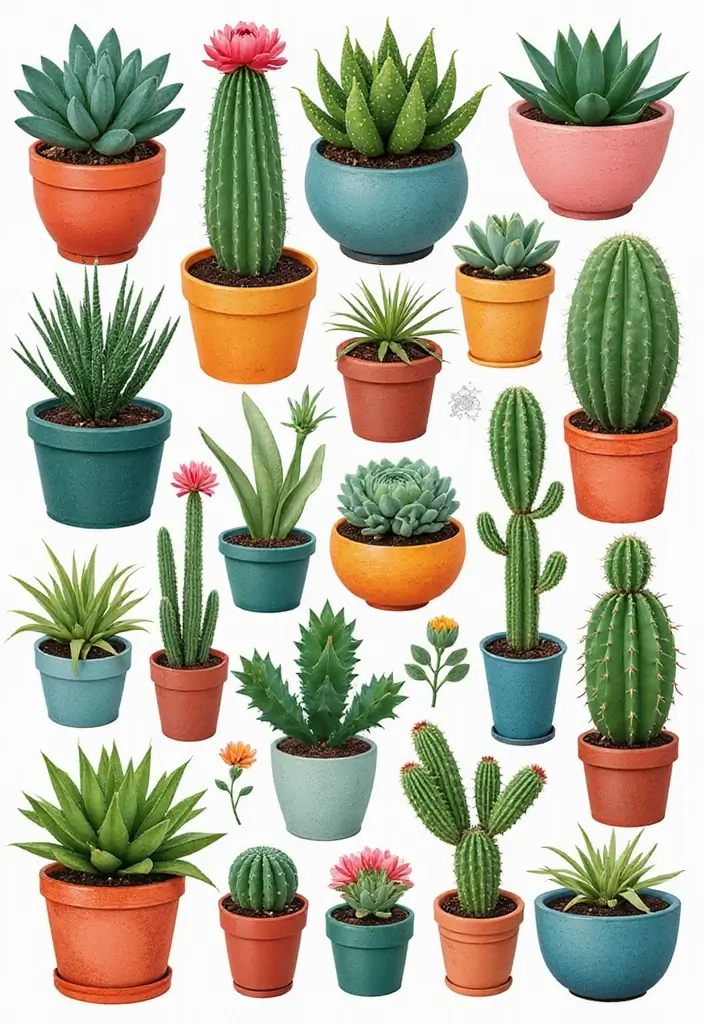
If you’re looking for a low-maintenance garden, consider succulents and cacti. These hardy plants not only thrive on neglect but also add stunning visual appeal. They come in various shapes, sizes, and colors, making them perfect for small spaces.
To showcase these drought-resistant beauties, use shallow containers, terrariums, or even hanging planters. For example, the Yesland ceramic hanging mini flower planters are a fantastic choice, allowing you to hang your succulents in an eye-catching display while saving floor space. Grouping different varieties can create a vibrant arrangement that draws the eye.
To ensure success with your plants, it’s essential to have the right materials. Start with a well-draining soil mix designed specifically for succulents, like the Back to the Roots 100% organic succulent & cacti mix. This premium mix provides the nutrition your plants need while promoting healthy growth.
Position your plants in bright, indirect sunlight for optimal growth and water sparingly, allowing the soil to dry out completely between waterings. If you’re interested in creating a more elaborate display, consider a complete setup like the succulent planter kit, which includes succulent soil, gravel, pebbles, and moss to help you craft a beautiful terrarium.
Creating a succulent or cactus garden can add a modern twist to your outdoor space, while their resilience means less time spent on upkeep.
7. Wildlife-Friendly Gardens: Nature’s Allies
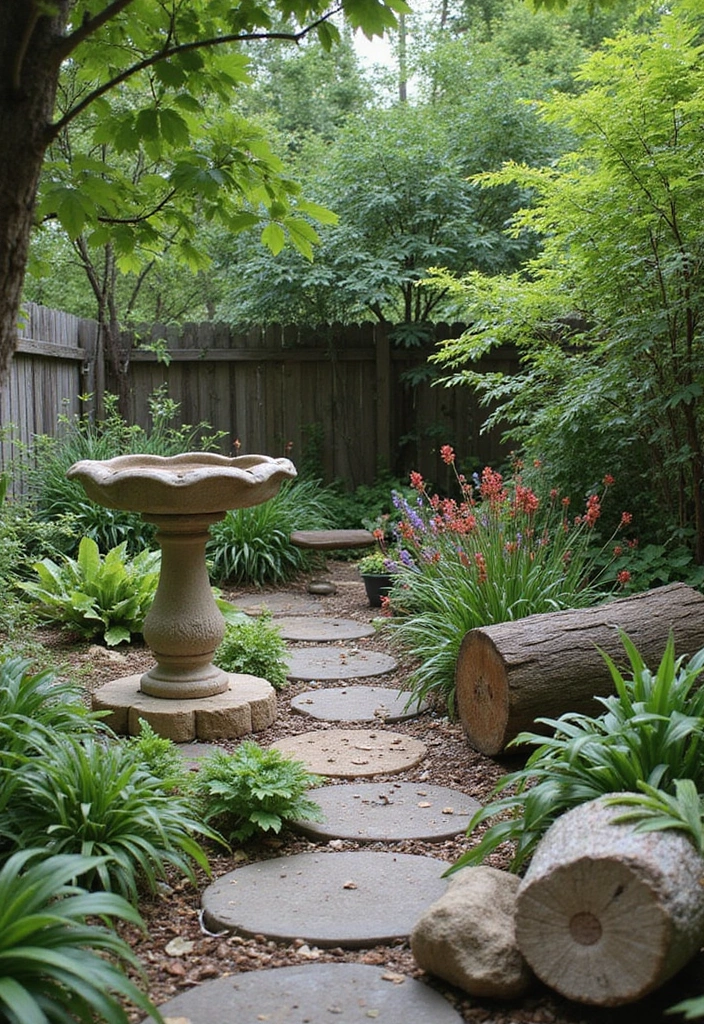
Encouraging wildlife to visit your small garden can create a dynamic, vibrant ecosystem. Native plants attract beneficial insects, while bird feeders and water sources invite local birds to make your garden their home. Incorporating native plants is crucial as they are adapted to local conditions and provide food and habitat for wildlife. Consider adding a Native Plant Seed Mix to your garden. This seed packet features a mixture of wildflowers that will not only add vibrant color but also attract pollinators, creating a more diverse habitat.
To make your garden more wildlife-friendly, you might want to include birdbaths or small ponds to provide water. A beautiful option is the Bird Bath, which has an antique copper finish and floral accents. This charming addition will invite local birds to visit while enhancing the aesthetic of your garden.
In addition, creating sheltering spaces with rocks, logs, or brush piles can support various creatures. You could also consider adding an Insect Hotel, designed to attract beneficial insects such as ladybugs and butterflies. This not only provides a safe haven for these important pollinators but also fosters biodiversity within your garden.
By crafting a wildlife-friendly garden with these elements, you help create a sustainable environment and foster a deeper connection with nature.
8. Pathways and Walkways: Define Your Space

Creating pathways and walkways can help define different areas within your small garden while adding visual interest. Using materials like stones, gravel, or wood, you can design paths that lead visitors through your garden, encouraging exploration.
For instance, consider using natural stone pavers to create a visually appealing and durable surface. These pavers not only blend seamlessly with your garden design but also establish clear walking routes that enhance the overall flow of the space.
Paths can be straight, curved, wide, or narrow, depending on your preferred style. Incorporating decorative gravel along the edges of pathways can add texture and color while also softening the look of your garden. This gravel can fill gaps and help prevent weeds, making your maintenance tasks easier.
Additionally, using wooden garden edging can effectively separate different areas of your garden, like vegetable patches from decorative flower beds. This not only organizes your space but also provides a charming border that frames your paths beautifully.
Well-designed pathways not only enhance the flow of your garden but also create a sense of tranquility and organization, inviting everyone to enjoy and explore your green sanctuary.
9. Creative Use of Space: Underutilized Areas
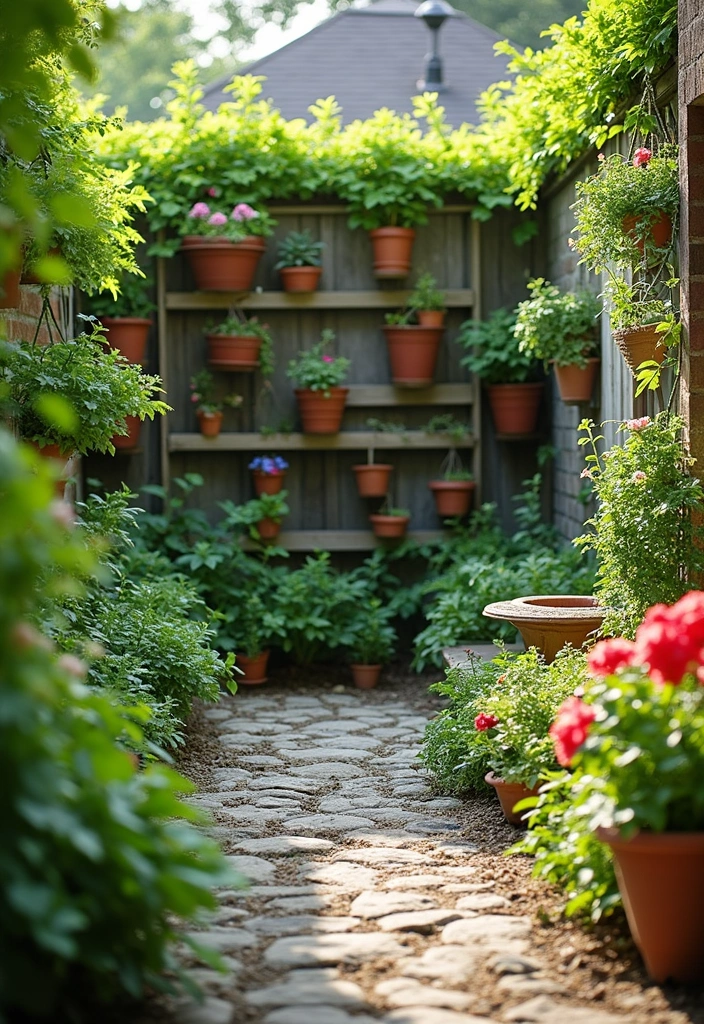
Think outside the box by utilizing underused areas in your garden. Spaces like fences, walls, and even the ground below can be transformed into beautiful garden features. For instance, you can use wall planters to create stunning vertical gardens—these self-watering planters are easy to install and perfect for displaying your favorite plants.
Don’t forget about the ground; adding low-growing plants like creeping thyme can fill gaps and provide a beautiful carpet of color. This non-GMO heirloom ground cover not only looks attractive but is also hardy and perfect for enhancing your garden.
Here are some more ideas for maximizing underutilized spaces:
– Attach railing planters to fences or railings for added greenery.
– Use climbing plants to cover unsightly walls. A vertical trellis can be a great support for your climbing plants, allowing them to thrive and create a lush backdrop.
– Consider planting edible ground covers like strawberries for a tasty twist.
By creatively using space, every inch of your garden can contribute to a vibrant, inviting atmosphere.
10. Seasonal Planting: A Year-Round Garden
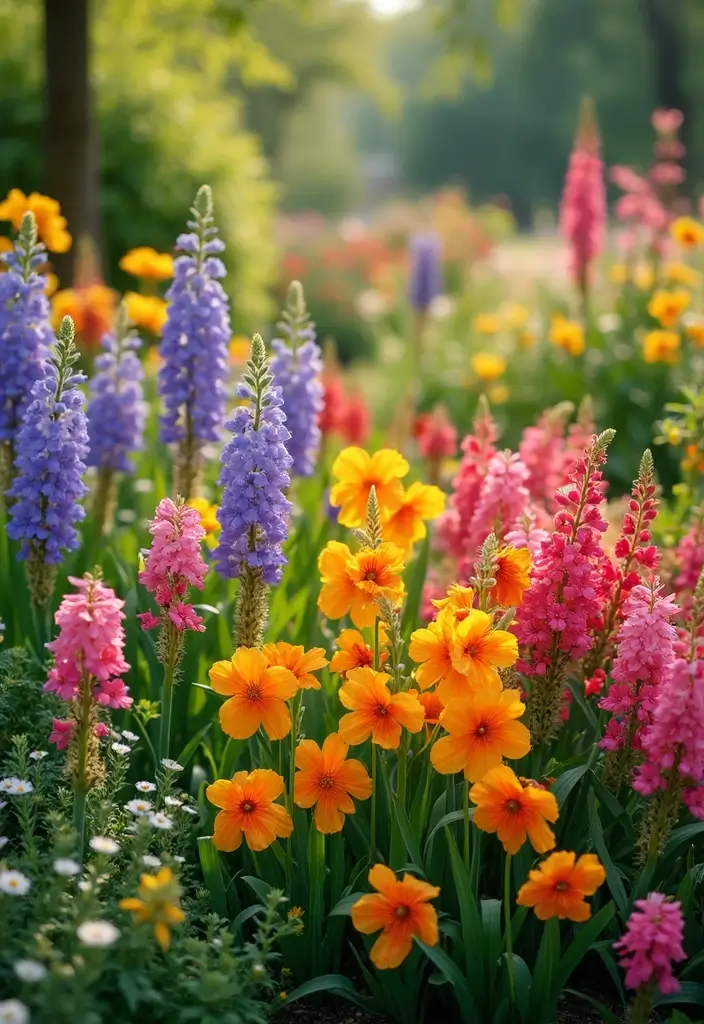
Plan for seasonal planting to ensure your small garden remains vibrant and interesting throughout the year. By selecting a mix of plants that bloom at different times, you can create a garden that evolves with the seasons.
Start your spring with early bloomers like crocuses and daffodils, which can easily be found in a seasonal flower bulbs assortment that offers 50 fresh bulbs to brighten up your garden. For the summer, choose vibrant flowers that will keep your space lively, while autumn foliage adds depth and interest as the leaves change. Incorporating evergreens, like the 2 Gal. Obsession Nandina shrub, provides a solid structure year-round, ensuring your garden remains visually appealing, even in the colder months.
To make seasonal planting work:
– Research the growing seasons for your favorite plants.
– Keep track of planting schedules with a handy garden planting calendar to help you plan and maintain a continuously beautiful garden.
Embracing seasonal planting not only keeps your garden fresh but also connects you with the changing rhythms of nature.
11. Garden Art: Adding Personal Touches
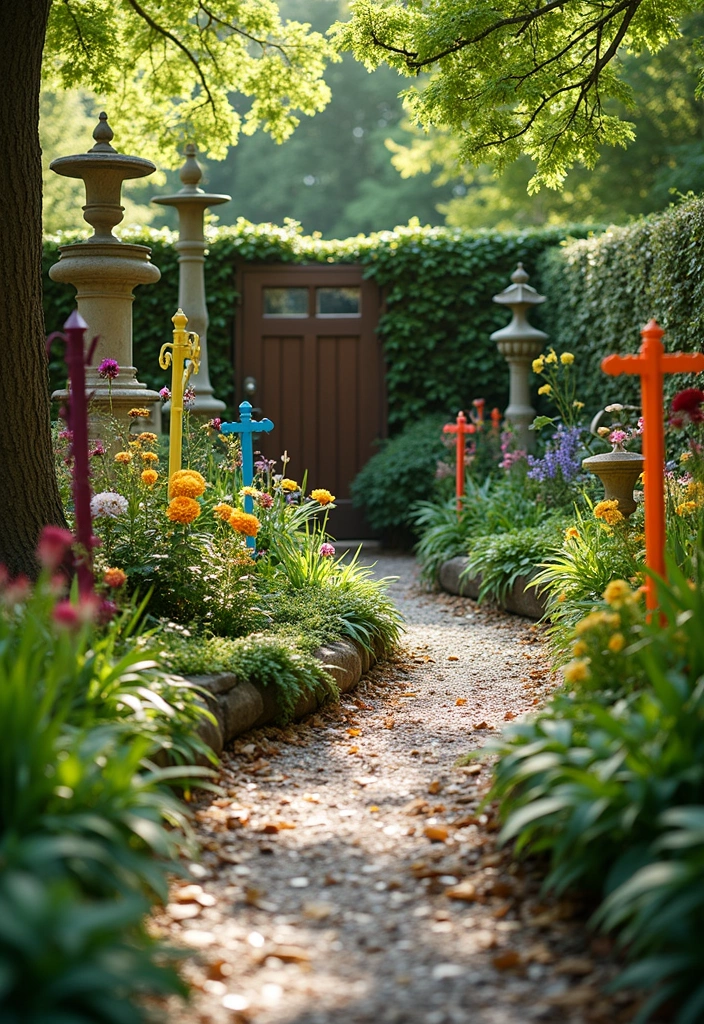
Incorporate unique garden art pieces to express your personality and add charm to your small garden. Items like sculptures, wind chimes, or colorful stakes can create focal points and enhance the overall aesthetic. For instance, a beautiful Lakeside Collection heart garden sculpture can serve as a captivating centerpiece, reflecting your style while inviting admiration from visitors.
Wind chimes, such as the deep tone soothing melodic wind chimes, not only add visual interest but also provide a soothing sound that enhances the ambiance of your garden. Their melodic tones can create a serene atmosphere, making your outdoor space feel more tranquil and inviting.
You can also create DIY art projects using recycled materials, adding a personal and eco-friendly touch. To add a splash of color, consider using colorful garden stakes. These vibrant stakes can help define areas in your garden while adding a playful element to the design.
To integrate garden art effectively:
– Choose pieces that complement your garden’s style and colors.
– Place art strategically to draw the eye and create interest.
– Be mindful of scale; choose art that suits the size of your garden.
Adding art to your garden can make it feel more inviting and personalized, turning an ordinary space into a reflection of your creativity.
12. Shade Gardens: Embracing the Understory
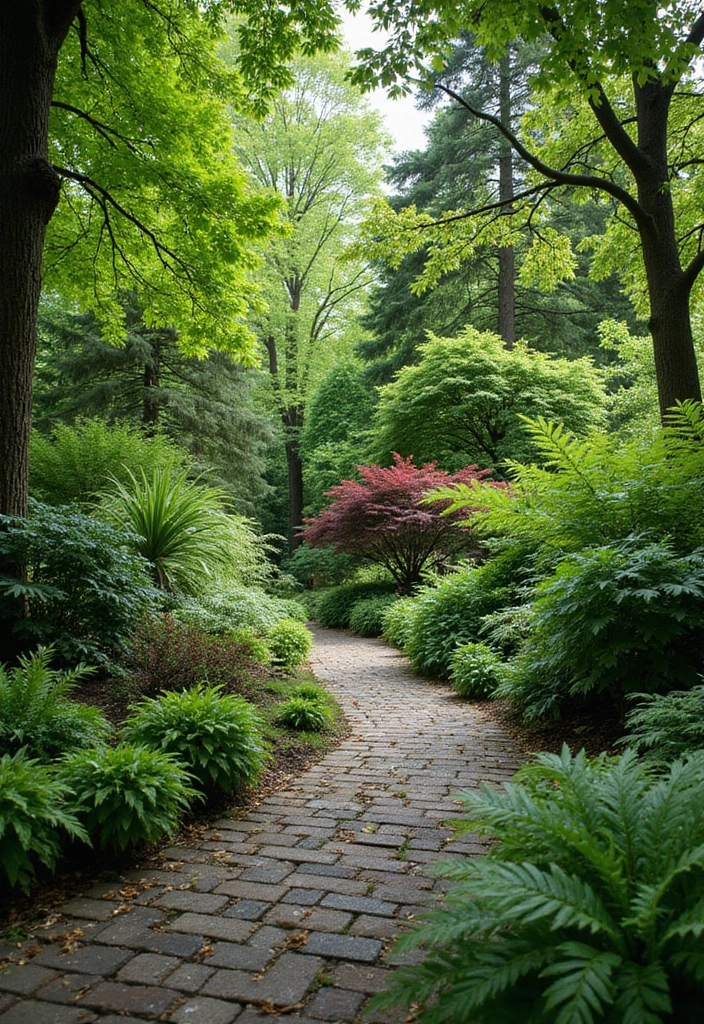
If your small garden is shaded by trees or buildings, don’t despair! A shade garden can be a lush retreat filled with diverse plant life. Choose shade-tolerant plants like hostas, ferns, and astilbes that thrive in low-light conditions. For a great start, consider using15000+ creeping thyme ground cover seeds for planting, a hardy option that can help establish a beautiful ground cover.
Designing a shade garden can be a unique challenge, but it offers opportunities for creativity. Mixing textures and colors can create a tranquil environment. Layer your plants to create depth, using taller varieties in the back and smaller ones in the front.
To enhance this serene space further, you could include some reflective surfaces. Addinggarden mirrors for reflective surfaces can brighten dark corners, making the garden feel more open and inviting.
Don’t forget about your soil; it’s essential for plant health. Usinggarden soil for shade plants will ensure that the right nutrients are available, supporting the growth of your chosen flora.
Trust your instincts; explore a variety of plants to see which ones thrive in your unique shade conditions. A well-planned shade garden can be a serene escape, providing cool refuge on hot days.
13. Indoor/Outdoor Gardening: Blurring the Lines
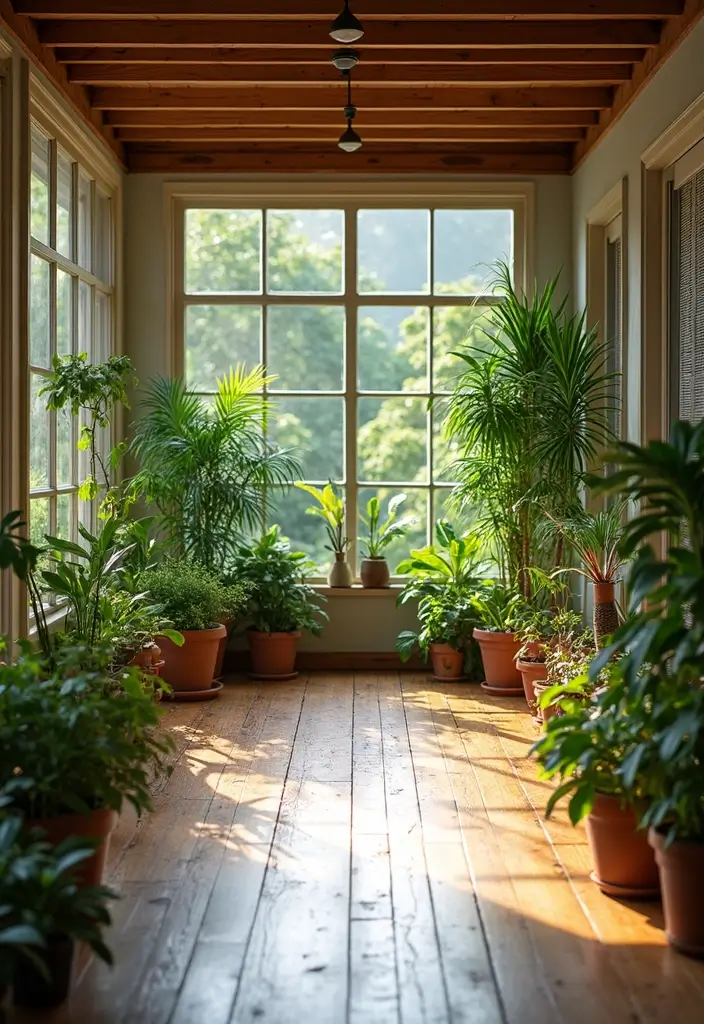
Create a seamless transition between your indoor and outdoor spaces by incorporating elements that connect them. Setting up an indoor potting area can provide flexibility in planting and planning, allowing you to nurture your plants in a comfortable environment.
Utilizing large windows or sliding doors can visually connect these spaces, inviting the outdoors in. An indoor herb garden kit is a wonderful way to establish a vibrant indoor herb garden that complements your outdoor plants. This kit includes non-toxic, BPA-free pots and organic seeds, making it ideal for cultivating fresh herbs right in your kitchen.
Additionally, consider a vertical plant stand that is suitable for both indoor and outdoor use. This 6-tier design allows you to maximize vertical space, just like you would outdoors, and provides an attractive way to display multiple plants in any corner of your home.
To unify the overall aesthetic, opt for decorative plant pots that resonate with your outdoor styles. The beaded ceramic planters come with drainage holes and saucers, making them practical for both indoor and outdoor settings.
Bridging the gap between indoor and outdoor gardening not only enhances the overall aesthetic but also brings a sense of harmony to your living space.
14. Recycling and Upcycling: Eco-Friendly Choices

Get creative by recycling and upcycling materials for your small garden design. Old furniture, pallets, and even kitchen containers can be transformed into unique planters or garden features. This not only saves money but also promotes sustainability.
For instance, consider using a vertical garden planter like the Mr. Stacky 5 Tier Stackable Strawberry, Herb, Flower, and Vegetable Planter. This product allows you to maximize vertical space, perfect for small gardens where ground space is limited.
You can also create upcycled benches or tables by giving old furniture a fresh look with products like Rust-Oleum Painter’s Touch latex paint. This outdoor paint is ideal for sprucing up older pieces and ensuring they withstand the elements, adding both character and durability to your garden.
If you’re looking for something more structured, the Idzo set of 2 hardwood outdoor flower boxes could be an excellent addition. These wooden pallet planters are made from durable acacia wood and come with ergonomic handles and drainage holes, making them perfect for various plants while also enhancing the aesthetic appeal of your garden.
To get started, look for items that can be easily transformed into plant containers, use paint or varnish to spruce up older pieces, and consider the durability of materials used outdoors. Recycling and upcycling can infuse your garden with character and creativity, all while being kind to the environment.
15. Garden Lighting: Magical Evenings
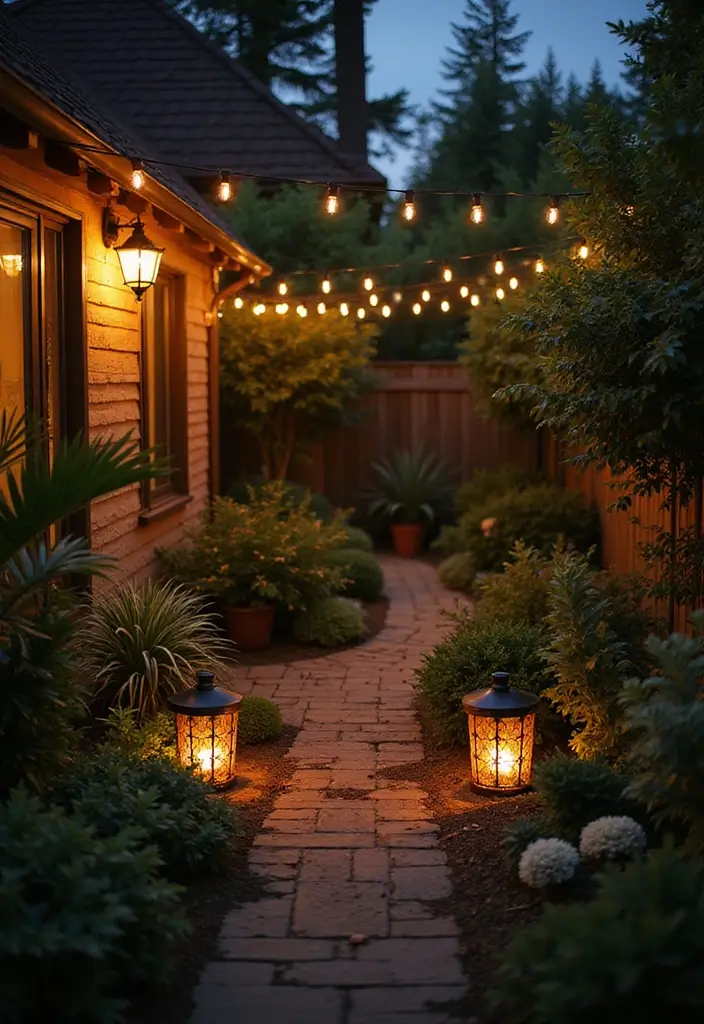
Enhance your small garden with strategic lighting to create a magical atmosphere during evenings. Using solar string lights can beautifully illuminate pathways and highlight your favorite plants. These 100FT lights come with remote control and three light modes, allowing you to customize the ambiance, while their waterproof feature ensures durability for outdoor use.
Additionally, consider incorporating solar lanterns into your garden design. These upgraded flickering flame lanterns not only add a charming touch but are also functional, providing soft illumination around your yard or patio. Their hanging design makes them versatile for various settings, enhancing the enchanting atmosphere.
To ensure your garden shines even when the sun goes down, warm white lighting is essential. The warm white LED garden lights are perfect for this, as they bring a cozy glow to your landscape. With their waterproof construction and sleek stainless steel stakes, these lights are ideal for lining pathways or accentuating garden features.
Thoughtful lighting design with these products can transform your garden into an enchanting retreat after sunset, allowing you to extend your enjoyment of the space into the evening hours, perfect for relaxation and socializing.
16. Companion Planting: A Natural Approach

Companion planting is a sustainable gardening practice that involves placing plants together that benefit each other. This method encourages biodiversity and can help deter pests naturally, making it perfect for organic gardening enthusiasts.
For example, planting marigolds alongside tomatoes can deter aphids, while basil can enhance the flavor of nearby tomatoes. To help you get started with companion planting, consider using a companion planting guide book to research plant compatibility; some plants thrive together while others hinder growth. This guide will provide valuable insights into which plants work best in harmony.
Additionally, keeping track of your plants can be made easier with garden plant labels. These labels will help you identify each plant type and monitor their progress over time, ensuring you can rotate crops each season for healthy soil and keep an eye on plant health to see which combinations perform best.
Companion planting is a simple yet effective way to promote plant health and improve your garden’s overall yield. With the right resources, you can make the most of every inch in your garden.
17. Organic Pest Control: Natural Remedies
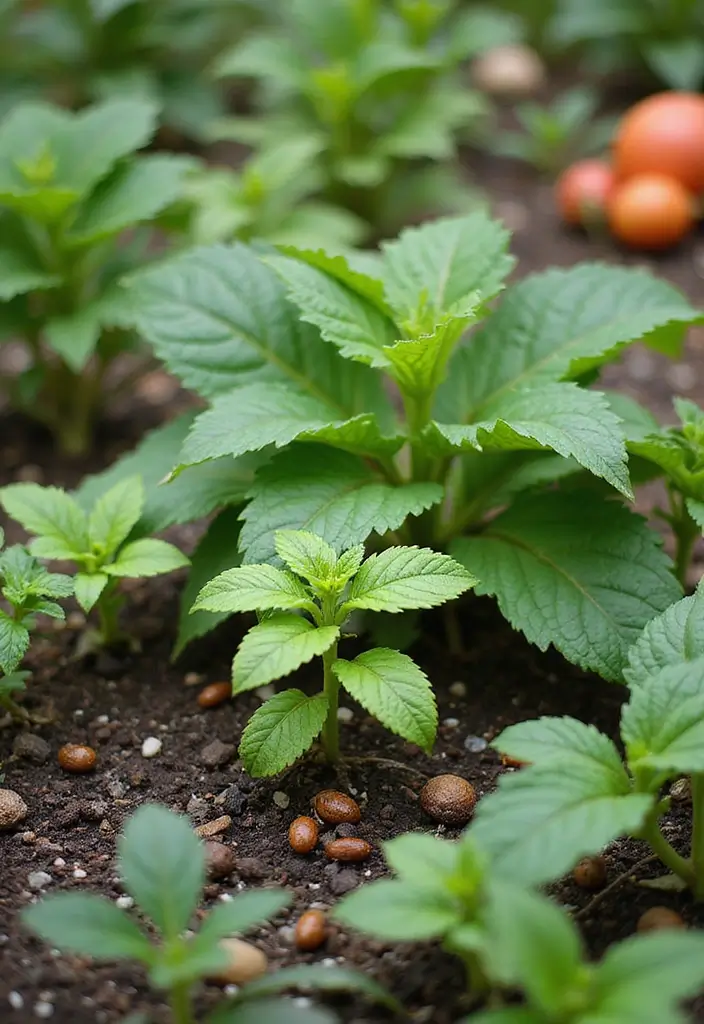
Managing pests can be one of the biggest challenges in organic gardening. Instead of reaching for harsh chemicals, consider natural remedies that can help control pests without harming the ecosystem.
For instance, using an onion and garlic spray can effectively deter aphids, while Neem Oil Concentrate is renowned for its efficacy against various insects. Additionally, introducing beneficial insects, like ladybugs, can also aid in pest management. You might consider a ladybug release kit that contains live beneficial nematodes, which help eliminate over 200 different species of soil-dwelling and wood-boring insects.
To incorporate organic pest control:
– Regularly inspect plants for early signs of pest problems.
– Use interplanting to confuse pests and promote beneficial insects.
– Research and apply homemade remedies that suit your specific pest issues.
Embracing organic pest control not only promotes a healthier garden but also contributes to a greener planet.
18. Rainwater Harvesting: Sustainable Watering
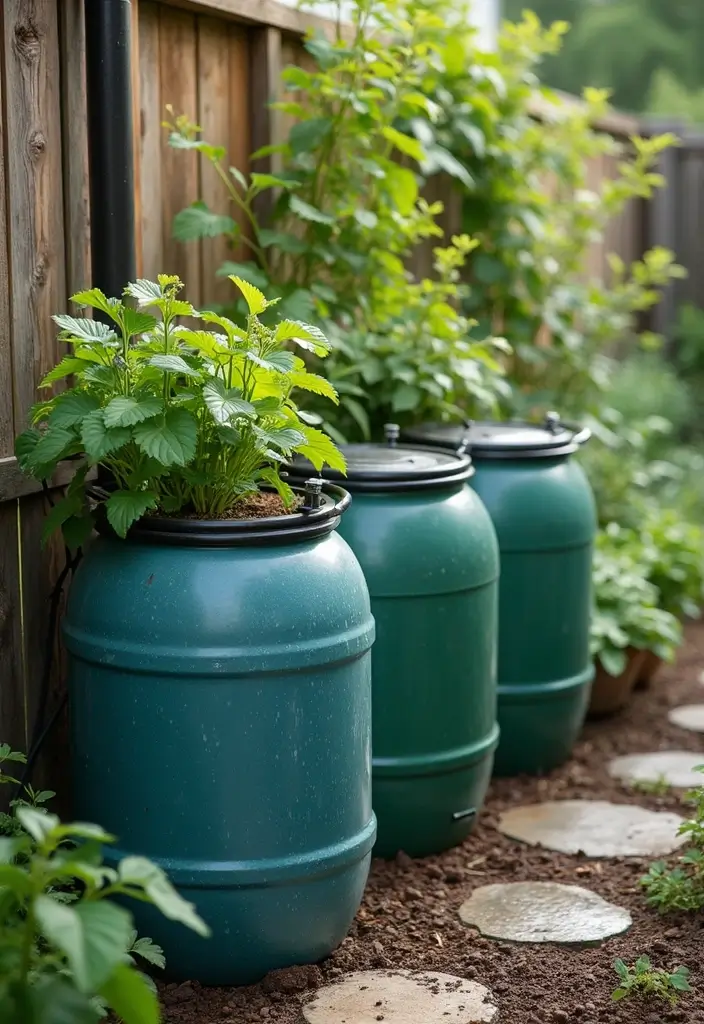
Rainwater harvesting is an eco-friendly way to keep your small garden hydrated. By collecting rainwater from roofs and surfaces, you can conserve water and reduce your utility bills. This method is particularly beneficial for organic gardening, where water quality is crucial.
To get started, consider setting up a rain barrel like the 50-gallon ECO rain barrel made with 100% recycled plastic. This flat back rainwater collection barrel is not only functional but also made from sustainable materials.
For maximum efficiency, position your collection barrels under gutters or downspouts. Furthermore, it’s essential to maintain the quality of the collected water. Installing a filter, such as the Maelstrom rainwater filter, ensures that debris is kept out, so your plants get the clean water they deserve.
Additionally, you might want to have a few food-grade water storage containers on hand. The Reliance Products Aqua-Tainer is ideal for storing water safely and conveniently for times when you need to water your garden during dry spells.
Incorporating rainwater harvesting can greatly reduce your environmental footprint while providing a natural water source for your plants.
19. Mulching: Healthy Soil, Happy Plants
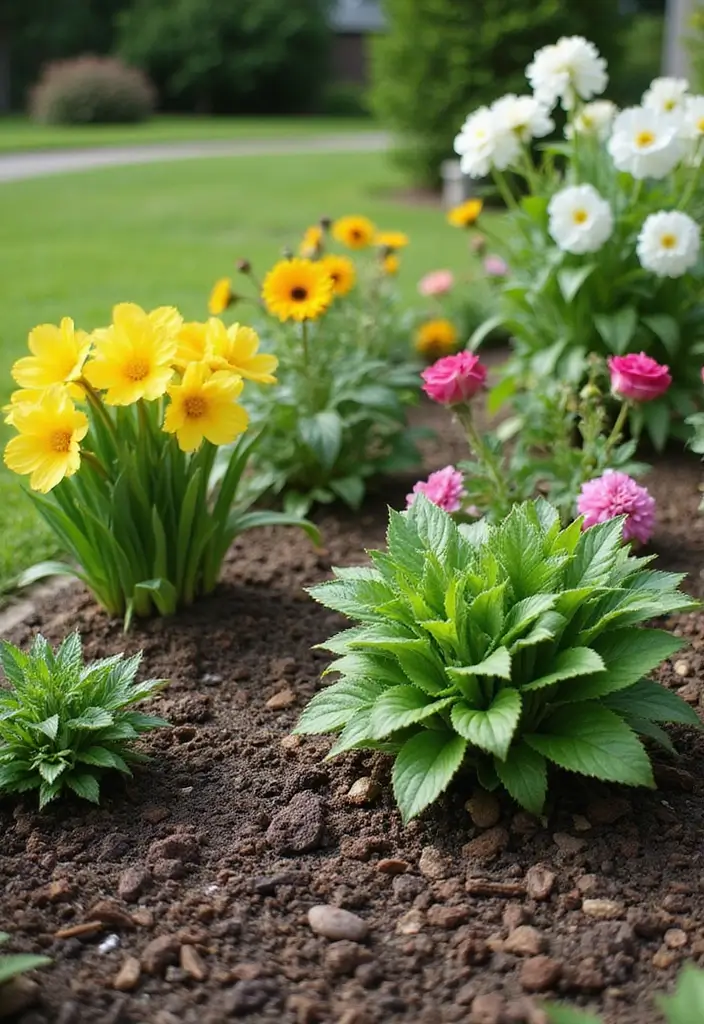
Mulching is a simple yet effective technique to enhance your small garden’s health. By adding a layer of organic mulch, you can improve soil quality, retain moisture, and inhibit weed growth.
Using materials like straw, wood chips, or grass clippings can add nutrients back into the soil as they decompose. For example, Back to the Roots organic mulch (wood chips) is an excellent choice for enhancing soil quality while providing a clean look to your garden beds. Alternatively, if you prefer a more natural approach, GardenStraw straw mulch not only suppresses weeds but also conserves water, making it ideal for vegetable gardens and lawns.
To get the most out of mulching:
– Apply a 2-4 inch layer around plants to suppress weeds and keep soil cool.
– Refresh mulch as needed to maintain its effectiveness.
– Choose organic materials that will benefit the soil over time, such as R&M Organics premium organic compost, which can further enrich the soil as it breaks down.
With regular mulching, your plants will thank you with healthy growth and vibrant blooms.
20. Seasonal Decorations: Festive Touches
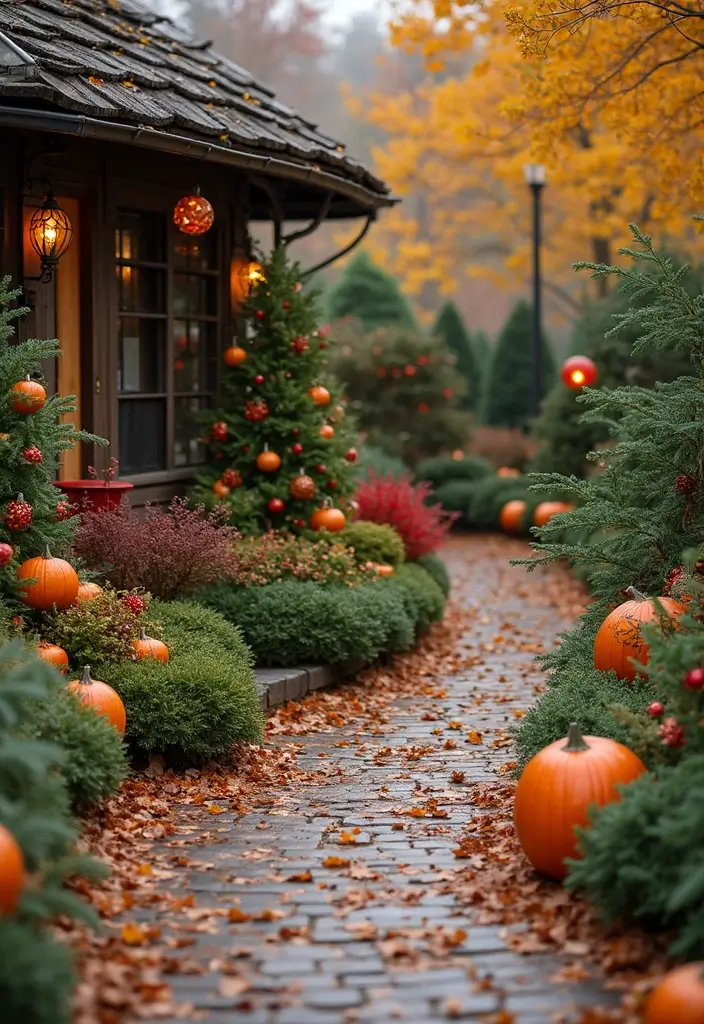
Adding seasonal decorations to your small garden can enhance its charm throughout the year. From autumn pumpkins to spring flowers, these accents keep your garden feeling fresh and inviting. You can invest in curated decorations or even make your own to personalize your space.
To incorporate seasonal decorations, consider using decorative garden flags like the AVOIN colorlife Spring Summer Floral Welcome Garden Flag. These flags can easily be rotated with the seasons, adding a welcoming touch that reflects the current time of year.
Another great addition is utilizing seasonal garden planters such as the Keter Urban Bloomer. This versatile planter not only enhances your garden’s aesthetic but also provides a practical solution for growing seasonal herbs and flowers, all while boasting a self-watering feature to keep them thriving.
Lastly, incorporating garden decorative stones, like the family stepping stone from Spoontiques, adds a personal and charming element to your outdoor space. These stones can complement your plants and help define pathways or garden borders, ensuring that your garden feels cohesive and inviting.
By thoughtfully rotating decorations with the seasons and selecting pieces that harmonize with your plants, you can elevate your small garden, making it a delightful space for relaxation and enjoyment.
21. Zen Gardens: Tranquil Spaces
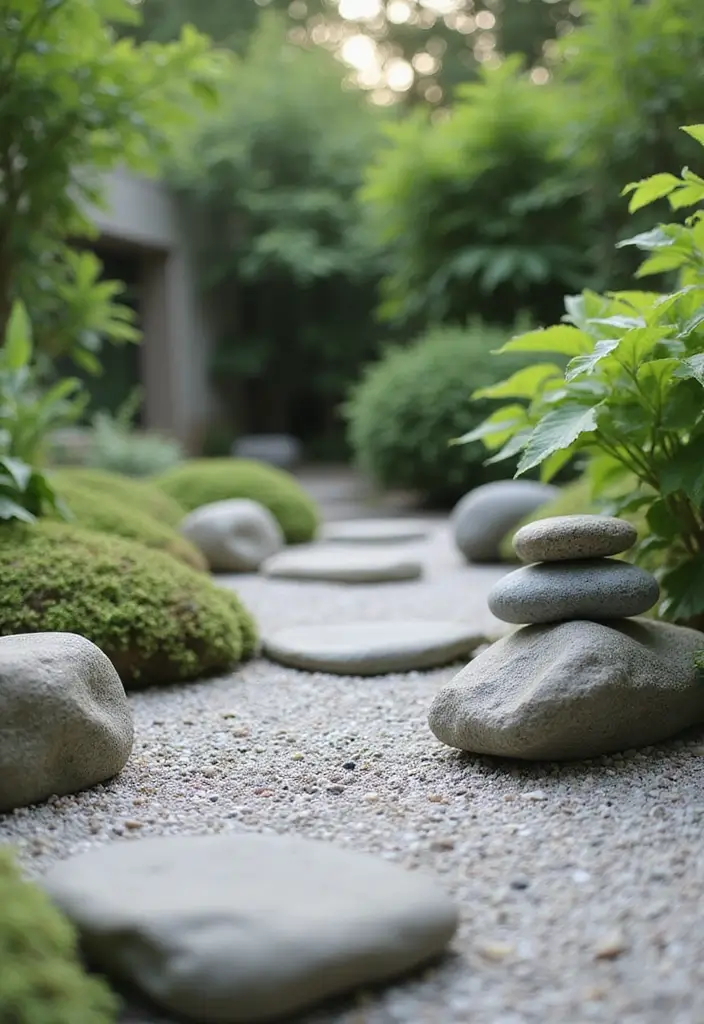
Consider creating a mini Zen garden in your small space for a peaceful retreat. Zen gardens typically focus on simplicity and natural materials, offering a serene environment. With elements like gravel, stones, and a few carefully chosen plants, you can create a calming space for relaxation and meditation. For instance, using natural gravel for landscaping is an excellent choice, as its fine texture creates soothing pathways and visually pleasing designs.
Larger stones can serve as focal points, adding structure to your garden. You might also consider a decorative feature such as the bamboo water fountain, which can enhance tranquility with the gentle sound of running water, making it a perfect addition to your Zen space.
To design a Zen garden:
– Use a limited color palette for plants and materials.
– Incorporate elements like the bamboo water fountain for added serenity.
– Keep the design minimal and balanced.
A Zen garden can provide a tranquil escape from the chaos of everyday life, allowing you to recharge and reflect. If you’re looking for an easy way to start, consider a Zen garden kit that includes everything you need, from tools to accessories, perfect for creating your oasis of tranquility.
A small garden can be a big retreat! Create your Zen space with simple materials and a mindful touch for the perfect oasis of tranquility.
22. Community Gardens: Joining Forces
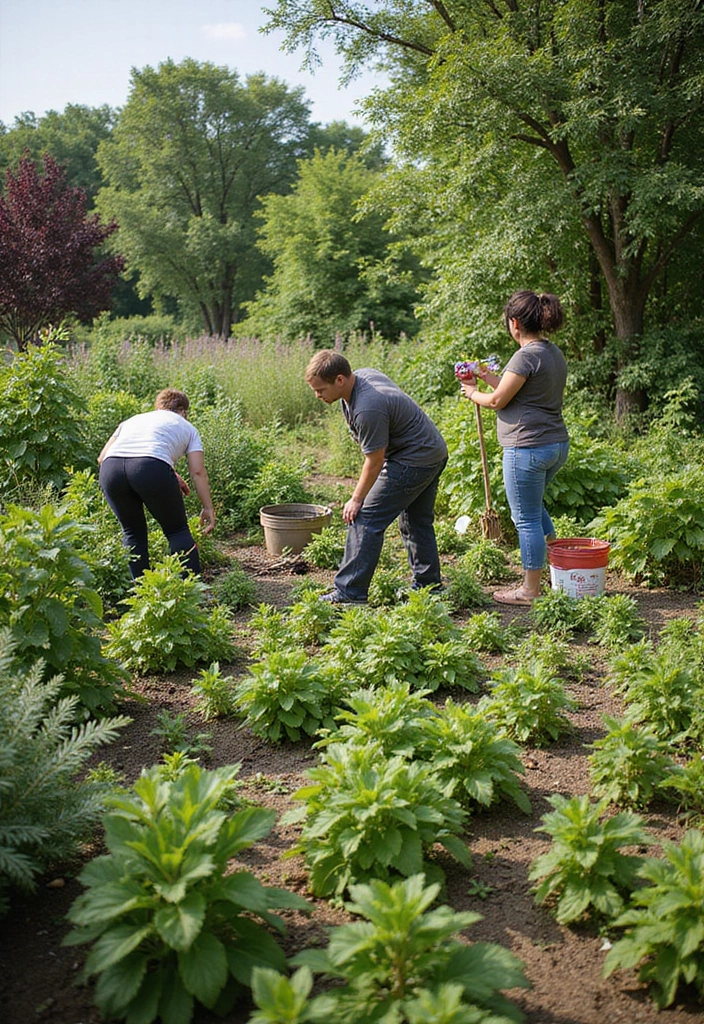
If space is limited, consider participating in a community garden. These shared spaces allow you to cultivate your love for gardening while connecting with neighbors. Community gardens often provide resources, knowledge exchange, and a sense of belonging.
You can collaborate on larger projects and share the harvest, creating a strong sense of community.
To get involved:
– Check local organizations for community gardening opportunities.
– Share tips and best practices with fellow gardeners.
– Participate in events or workshops to learn more.
Joining a community garden can enrich your gardening experience, making it about more than just growing plants.
23. Gardening Journals: Documenting Progress
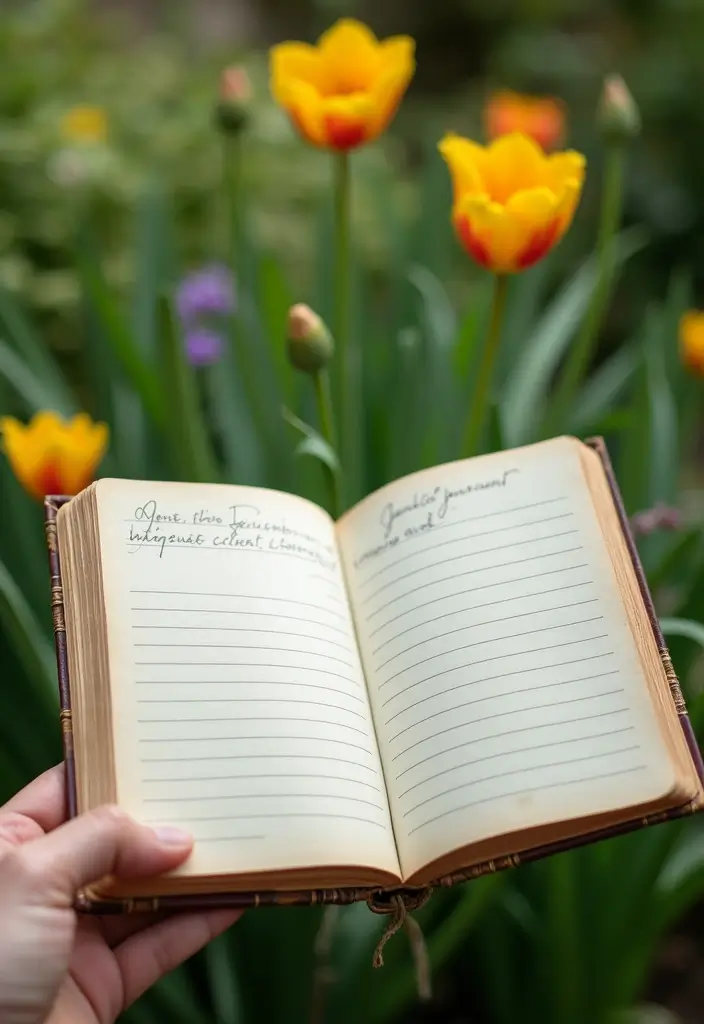
Keep a gardening journal to document your small garden’s progress over time. This practice not only helps track what works and what doesn’t but also allows you to reflect on your gardening journey.
You can jot down planting dates, growth observations, and seasonal changes, creating a personalized record of your garden’s evolution. To enhance this experience, consider using the Clever Fox Gardener’s Journal. This guided gardening notebook is perfect for tracking vegetables, flowers, and herbs over a five-year span, making it an invaluable tool for beginners.
To maintain an effective gardening journal:
– Include photos to visualize your progress.
– Note down any challenges faced and how they were resolved.
– Use the journal to plan future gardening endeavors.
Additionally, having a resource like the Old Farmer’s Almanac Vegetable Gardener’s Handbook can support your efforts by providing valuable information and tips tailored for small gardens.
A gardening journal can enhance your gardening skills and deepen your relationship with your green space, helping you grow not only plants but also your knowledge and confidence as a gardener.
24. Educational Workshops: Learning Together
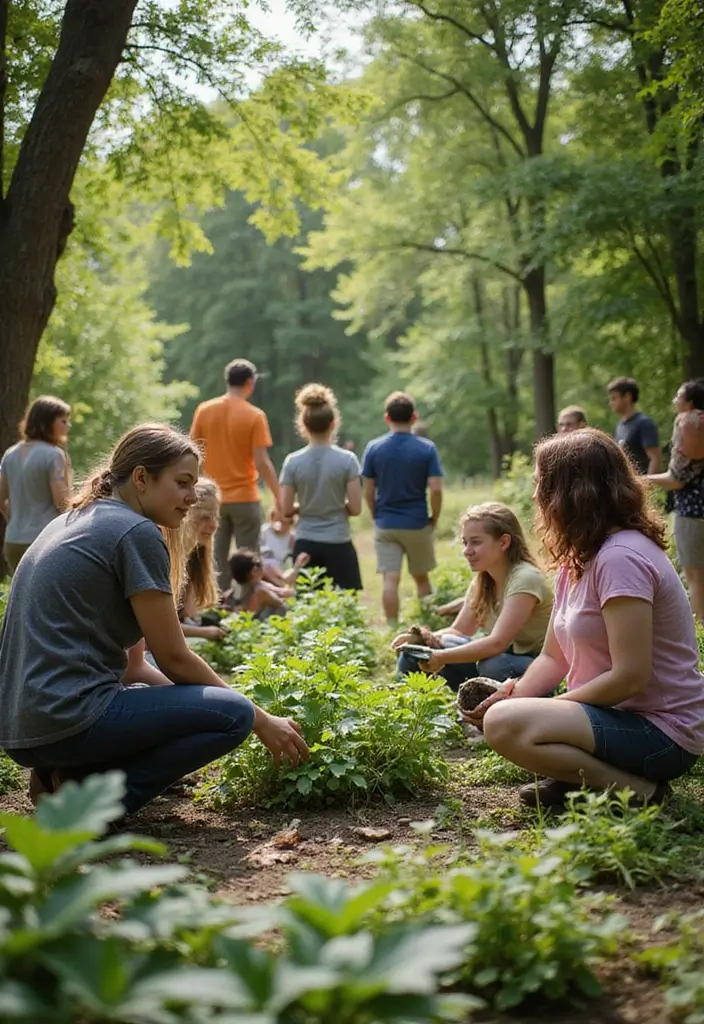
Participating in educational workshops can deepen your gardening knowledge and improve your skills. Look for local classes that focus on organic gardening, sustainable practices, or specific plant care techniques. Workshops often provide hands-on experience and the chance to learn from seasoned gardeners.
To enhance your learning experience, consider equipping yourself with a reliable gardening tool set. This comprehensive 9-piece heavy duty gardening hand tools kit is not only rust-proof but also comes with a fashionable and durable organizer handbag, making it an ideal companion for any workshop or gardening session. Utilizing quality tools can make tasks easier and more enjoyable, allowing you to focus on learning and applying new techniques.
Here’s how to find and participate in workshops:
– Check community centers, botanical gardens, or local nurseries for offerings.
– Engage with fellow attendees to exchange tips and stories.
– Don’t hesitate to ask questions and seek advice.
Additionally, consider reading up on best practices for gardening with the Organic Gardening Book. This handbook can provide you with invaluable insights and techniques that you can implement right away, complementing the knowledge gained from workshops.
If you’re looking to maximize your gardening space, think about investing in a raised garden bed kit. This galvanized planter is perfect for growing vegetables in smaller areas, helping you create a thriving garden even in limited space.
Attending workshops can ignite your passion for gardening and empower you with the knowledge and tools to cultivate a flourishing small garden.
25. Online Gardening Communities: Connect and Share
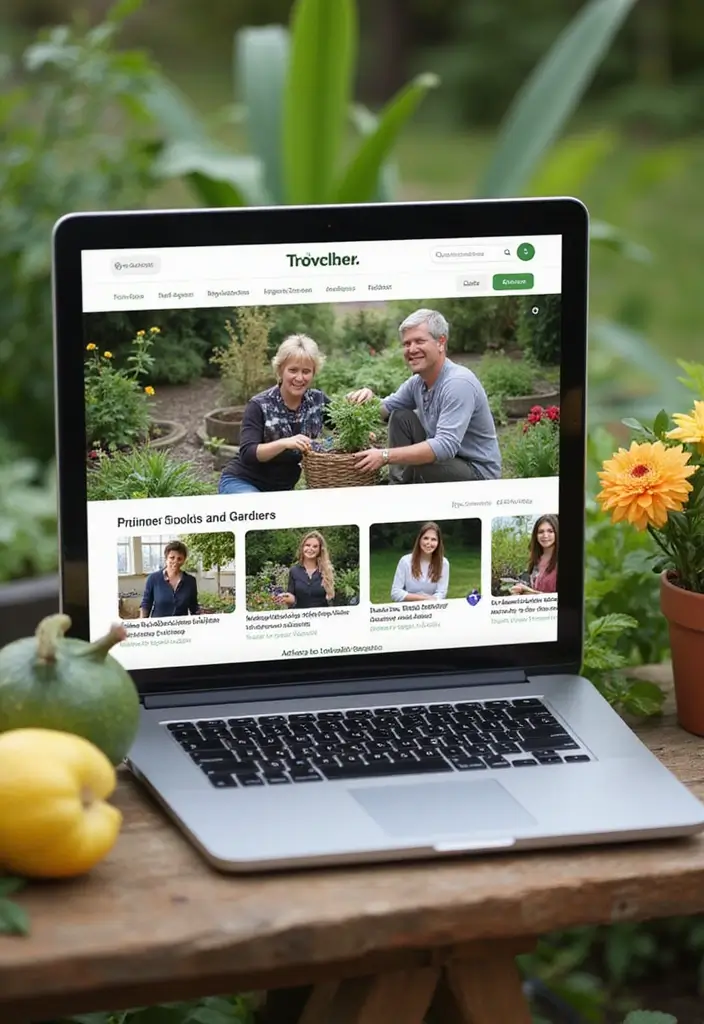
Join online gardening communities to connect with fellow enthusiasts and share your small garden journey. These platforms allow you to exchange tips, ask questions, and showcase your progress.
Facebook groups, Instagram hashtags, and gardening forums are great places to interact with others and gain inspiration.
To make the most out of online communities:
– Actively participate by sharing your experiences and insights.
– Seek advice on challenges you face in your gardening journey.
– Celebrate your successes and share your garden’s beauty with others.
Online gardening communities can enrich your gardening experience, providing support and friendship among fellow plant lovers.
Your small garden design journey is richer when shared! Connect with fellow enthusiasts online, exchange tips, and find inspiration to grow together. Let’s cultivate community and knowledge, one garden at a time!
Conclusion: Your Small Garden Awaits!
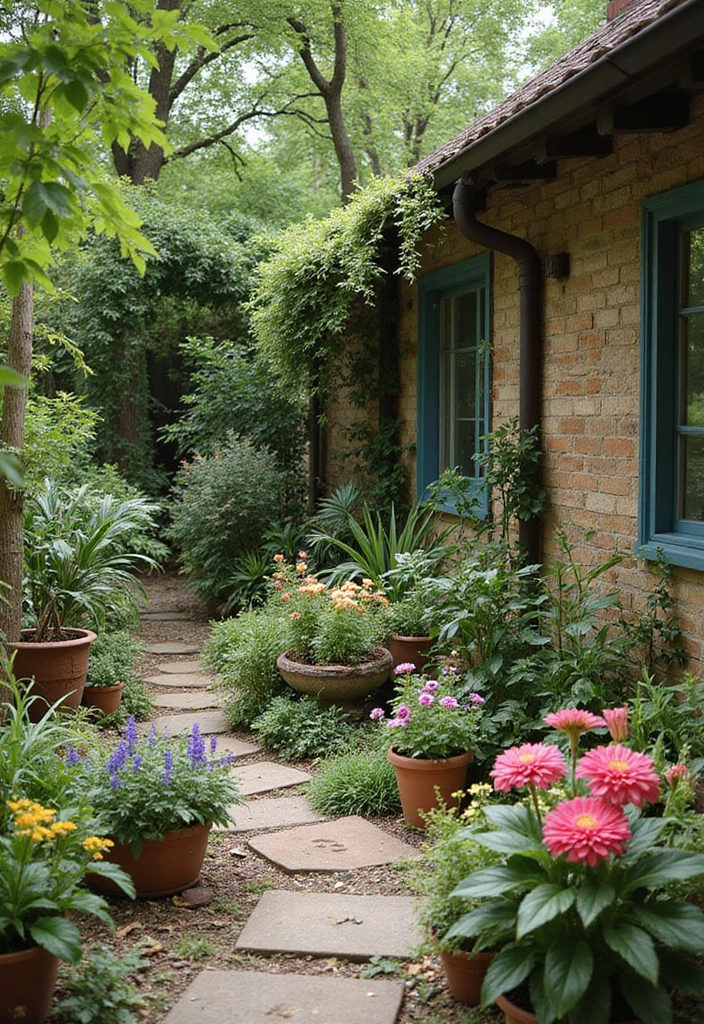
Maximizing your small garden with these 25 design ideas can pave the way for a lush and productive space. Embracing creativity, sustainability, and community will help you transform even the tiniest corner into a vibrant oasis that reflects your personal style.
As you embark on your gardening journey, remember that every inch counts, and with a little planning, your small garden can blossom into a beautiful, nourishing retreat. Happy gardening!
Note: We aim to provide accurate product links, but some may occasionally expire or become unavailable. If this happens, please search directly on Amazon for the product or a suitable alternative.
This post contains Amazon affiliate links, meaning I may earn a small commission if you purchase through my links, at no extra cost to you.
Related Topics

